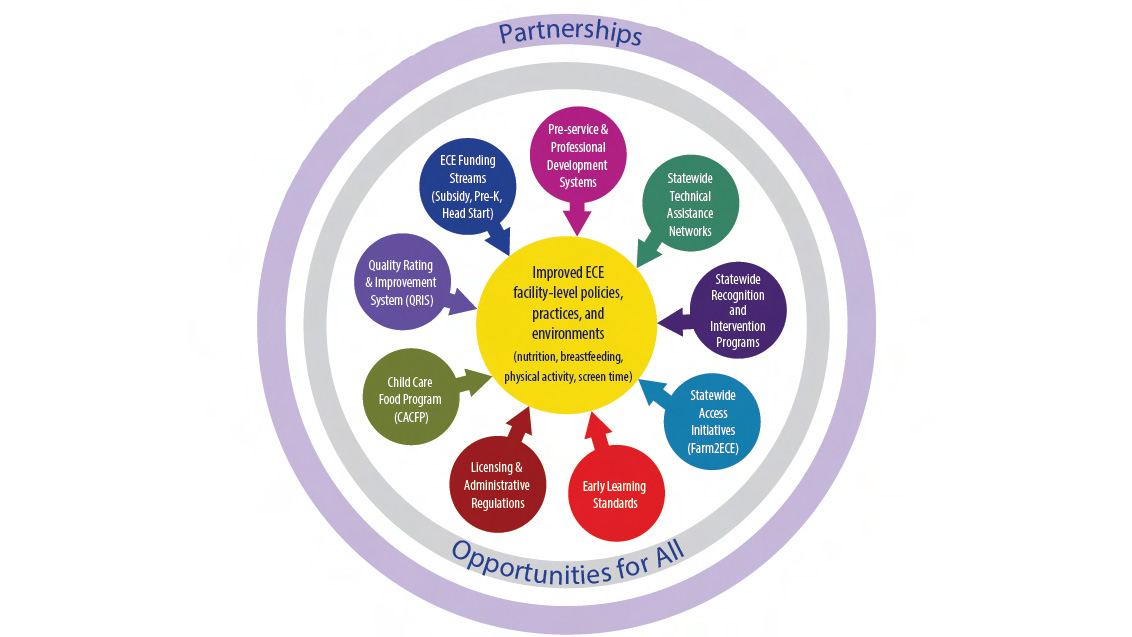Key points
- Most young children spend time in care outside of their home.
- State and local organizations can implement policies and activities that improve nutrition, physical activity, and breastfeeding in early care and education (ECE) settings.

Background

About 12.5 million US children up to age 5 who are not yet in kindergarten are in a nonparental care arrangement, such as daycare, at least once a week. That's 3 in 5 children younger than 5. The number of children in ECE programs makes it one of the best settings to help young children build a foundation for healthy living.
High-quality ECE programs positively influence a child's social, emotional, educational, physical, and economic outcomes later in life. Children affected by poverty may benefit even more from high-quality ECE programs. Activities to support healthy behaviors, healthy growth, and development in ECE settings include increasing access to healthy foods, breastfeeding, physical activity, and Farm to ECE.
States and communities can support children's healthy growth and development in ECE at three levels: state systems, ECE programs, and ECE providers. This approach helps ECE programs improve their policies and practices.
Potential activities from CDC's Spectrum of Opportunities

Complete a partnership assessment.
- State partners may include task forces or advisory committees with early childhood foundations, state ECE professional organizations, state child nutrition program representatives, and ECE programs.
- Also consider connecting with state breastfeeding coalitions and state Farm to School or Farm to ECE coalitions.
- Local partners may include regional or county representatives from Supplemental Nutrition Assistance Program Education (SNAP-Ed) staff, Head Start programs, organizations that sponsor the Child and Adult Care Food Program, childcare resource and referral agencies, Cooperative Extension Services, and ECE programs and providers.
Begin with the ECE Quick Start Action Guide with its comprehensive roadmap and series of worksheets.*
Identify areas of focus within CDC's Spectrum of Opportunities. Determine what assets, resources, and state activities exist in each area.
- States can develop an action plan that builds on existing work to advance one or more Spectrum areas that are most feasible.*
- Local communities can determine which state assets and resources to build on. Communities can identify priority areas or topics and work with ECE programs in their jurisdiction to make improvements.*
Work with state and local partners to engage ECE programs in your state or community:
- Use learning collaboratives or other models to engage state and local groups to work on improving a specific topic area such as nutrition, physical activity, breastfeeding or Farm to ECE.*
- Reduce engagement barriers, such as cost, technology requirements, and time to engage in trainings, across groups of ECE programs.+
Build equity into state and local ECE work.
- Expand ECE coalitions to include ECE care providers and various cultural and socio-economic groups.*
- Create cultural and linguistic translations of support and guidance products that work for the populations served.*
- Participate in federal programs that reimburse ECE providers caring for children in families that meet income eligibility, such as your state's Child and Adult Care Food Program and Child Care and Development Fund.+
- Use a health access assessment tool, such as those in the Health Access Resources section below, to inform the work.*
- Use data sets, such as the Child Opportunity Index, to identify communities and areas with the greatest health disparities for the program's focus.*
Activities for states and local communities by spectrum area
Licensing and administrative regulations
Each state sets ECE regulations, making regulations an important area for potential policy interventions. Use your state's ECE licensing scorecard to know what obesity prevention standards are included. Learn more about state licensing efforts and ways to advance this Spectrum area.*
Quality Rating and Improvement Systems (QRIS)
QRIS is a systematic approach to assessing, communicating, and improving quality in ECE programs. See if your state has incorporated any of the 47 high-impact obesity prevention best practices into its state QRIS system.*
Child and Adult Care Food Program (CACFP)
This nutrition program from the US Department of Agriculture can help reimburse participating ECE programs for supporting breastfeeding parents and serving healthy meals and snacks to eligible children in their care. You can contact your state CACFP program for additional information.
- State: Identify ECE programs participating in CACFP in your state and any gaps in participation associated with geographically and socially vulnerable areas.* CACFP maps provide information about CACFP participation in select states. As needed, increase participation through activities such as education or promotional materials, technical assistance, and outreach.+
- Local: Educate eligible ECE programs in your community about the CACFP program.* Consider efforts to increase participation, such as mentoring or outreach efforts.+
Professional development
Professional development refers to ongoing professional training for ECE providers. Professionals learn about best practices and advance their knowledge and skills on a topic.
- State: Inventory professional development modules or trainings available to help ECE providers learn about nutrition, physical activity, breastfeeding, Farm to ECE, or other relevant topics. Also, providers may create or update trainings as needed.*
- Local: Promote state modules or trainings for ECE providers in your community.*
Promote the use of modules and trainings to reach as many ECE providers as possible.+ Reduce common professional development barriers, such as cost, language, and distance.
Statewide intervention programs
Evidence-based interventions can help ECE programs improve their polices, practices, and nutrition and physical activity offerings. See the SNAP-ED Toolkit for examples such as GO NAPSACC, CATCH Early Childhood, Cooking Matters, and Harvest for Healthy Kids.
- State: Identify an evidence-based intervention that all ECE programs in your state can implement to help improve nutrition and physical activity policies and practices. Work with ECE programs in your state to use the intervention.+
- Local: Determine if your state has an evidence-based intervention. If so, work with ECE programs in your community to use the intervention or tool. If not, consider if GO NAPSACC or another intervention is right for your community.+
Statewide recognition programs
State-branded recognition programs identify ECE programs that meet criteria on a particular topic. Many states have breastfeeding-friendly, healthy childcare, or other nutrition or physical activity recognition programs.
- State: Find out if your state has a recognition program. Work with partners to implement or increase use, as appropriate.+ If your state does not have a program, consider working with your state’s ECE partners to create one.
- Local: Find out if your state has any ECE recognition programs. If it does, provide information and encourage community ECE programs not yet participating to enroll or consider taking part in a pilot.+ If not, consider working with your state’s ECE partners to create one.+
Statewide technical assistance networks
State technical assistance (TA) networks provide ECE programs with individualized help on a variety of topics. Common TA providers include staff at state childcare resource and referral agencies, local health departments, childcare health consultants, SNAP-Ed coordinators, and ECE trainers.
- State: Identify existing groups that provide TA to ECE programs.*
- Work with TA networks and TA providers to increase knowledge and build ECE program capacity on "topics" such as nutrition, physical activity, breastfeeding, outdoor learning, and Farm to ECE. If your state usesan evidence-based intervention or a recognition program, encourage TA providers to use the state-sponsored intervention or recognition programs with ECE programs they serve.+
- Local: Find out who provides support and TA to ECE programs in your community.*
- Work with TA networks and TA providers to increase TA on nutrition, physical activity, breastfeeding, outdoor learning, or Farm to ECE.+
Access to healthy environments
Farm to ECE programs provide increased exposure and access to local produce, opportunities to learn about nutrition and agriculture, and hands-on learning through gardening.
State:
- Join or start a Farm to ECE coalition to advance Farm to ECE.*
- Engage local and regional food system and ECE partners.+
- Build capacity through training and TA opportunities.+
Local:
- Learn what your state has done to advance Farm to ECE.*
- Connect with state and local Farm to ECE coalitions and partners, work to engage community ECE programs on Farm to ECE, and build capacity through training and TA opportunities.+
Outdoor Learning Environments (OLEs) help young children be more physically active while they play, discover, and connect with nature.
State: Build capacity and knowledge about OLEs through training and TA.
- Find out if there is a state network of professionals who can help design and implement OLEs featuring OLE best practices.*
- Create and distribute resources for professionals from key disciplines such as landscape architects, ECE staff, horticulturalists, ECE licensing professionals, and nature play specialists. These experts can help ECE programs implement high-quality OLEs.+
Local:
- Identify what your state has done to increase access to high-quality OLEs.*
- Connect with state and local coalitions and partners and engage ECE programs in your community in OLE through training and TA opportunities.+
Working together
Examples from CDC-supported programs:
Advancing Farm to ECE
Provides overview of Farm to ECE and includes short stories from seven states.
Advancing Early Child Nutrition in Early Care and Education
Provides overview of Early Child Nutrition in Early Care and Education, how states and communities can advance this strategy, and includes short stories from three states.
New Mexico Early Care and Education Centers Create Lasting Wellness Changes
Describes a policy toolkit for putting policy changes into practice.
Making Health Easier: Healthy Changes Start in Preschool
Highlights Los Angeles Universal Preschool's efforts to teach children healthy habits by incorporating small, healthy changes that can be made in any classroom.

Resources
CDC's Spectrum of Opportunities Framework
Describes nine components for states and communities to consider when improving policies, practices, and environments in ECE programs. Related resources include:
- Spectrum of Opportunities for Obesity Prevention in Early Care and Education is a summary graphic with examples of potential activities in the nine spectrum areas.
- Quick Start Action Guide for Obesity Prevention in ECE provides action steps to plan new or expand existing efforts to promote healthy eating, physical activity, and breastfeeding in ECE. Includes partnership worksheets and can be adapted for local use.
- Also see Go NAPSACC in the Spectrum of Opportunities.
Strategies to Prevent and Manage Obesity in the ECE Setting
Includes background on the ECE setting, key CDC publications, and resources.
Early Care and Education State Indicator Report (2023)
Highlights how states have advanced seven Spectrum of Opportunities areas. Use to understand existing efforts to improve ECE programs and help ECE providers implement nutrition, physical activity, breastfeeding, and Farm to ECE support and reduce screen time.
Farm to Preschool: Local Food and Learning in Early Care and Education Settings
Fact sheet includes tips for growing a program.
Healthy Kids, Healthy Future
Resources for ECE trainers, providers, and state and local leaders.
Cross-cutting areas
Communication tips to support program efforts.
Evaluation framework for making evaluations useful, feasible, ethical, accurate, and culturally responsive.
Health access tools to help remove barriers to health.
Definitions
CDC's Spectrum of Opportunities is sometimes called CDC Spectrum Areas. It offers nine avenues for states and communities to consider when working to improve nutrition, physical activity, and breastfeeding support. The Spectrum Areas can be used in all types of ECE programs to meet best practice standards for national obesity prevention.
Early care and education includes many types of childcare programs, such as child care centers, family child care homes (also known as in-home child care), preschool and prekindergarten programs, and Head Start and Early Head Start.
Farm to ECE is a set of strategies and activities that offers children in ECE programs increased access to local produce, opportunities to learn about nutrition and agriculture, and hands-on learning through gardening.
National Caring for Our Children Standards includes 47 best practice standards that can have a high impact on obesity. The standards can be used to improve nutrition, physical activity, breastfeeding, and screen time in ECE programs. States can include these standards in ECE work to promote the development of healthy habits in young children.
Outdoor learning environments promote nature-based outdoor spaces for ECE programs to support children's physical activity and healthy eating, outdoor learning, social-emotional development, and mental health.
Additional priority strategies
Breastfeeding Continuity of Care
Increasing Physical Activity Through Community Design
Family Healthy Weight Programs
